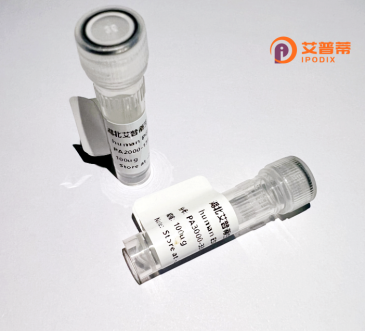
| 纯度 | >90%SDS-PAGE. |
| 种属 | Human |
| 靶点 | TMEM150 |
| Uniprot No | Q86TG1 |
| 内毒素 | < 0.01EU/μg |
| 表达宿主 | E.coli |
| 表达区间 | 1-271 aa |
| 活性数据 | MTAWILLPVSLSAFSITGIWTVYAMAVMNHHVCPVENWSYNESCPPDPAEQGGPKTCCTLDDVPLISKCGSYPPESCLFSLIGNMGAFMVALICLLRYGQLLEQSRHSWVNTTALITGCTNAAGLLVVGNFQVDHARSLHYVGAGVAFPAGLLFVCLHCALSYQGATAPLDLAVAYLRSVLAVIAFITLVLSGVFFVHESSQLQHGAALCEWVCVIDILIFYGTFSYEFGAVSSDTLVAALQPTPGRACKSSGSSSTSTHLNCAPESIAMI |
| 分子量 | 55.2 kDa |
| 蛋白标签 | GST-tag at N-terminal |
| 缓冲液 | PBS, pH7.4, containing 0.01% SKL, 1mM DTT, 5% Trehalose and Proclin300. |
| 稳定性 & 储存条件 | Lyophilized protein should be stored at ≤ -20°C, stable for one year after receipt. Reconstituted protein solution can be stored at 2-8°C for 2-7 days. Aliquots of reconstituted samples are stable at ≤ -20°C for 3 months. |
| 复溶 | Always centrifuge tubes before opening.Do not mix by vortex or pipetting. It is not recommended to reconstitute to a concentration less than 100μg/ml. Dissolve the lyophilized protein in distilled water. Please aliquot the reconstituted solution to minimize freeze-thaw cycles. |
以下为与重组人TMEM150蛋白相关的参考文献示例(基于公开发表的研究内容总结):
1. **文献名称**: TMEM150A is a potential modulator of adipogenesis and lipid metabolism
**作者**: Zhang Y, et al. (2021)
**摘要**: 该研究首次报道了重组人TMEM150A蛋白在脂肪细胞分化中的作用,发现其通过调控PPARγ通路影响脂质代谢,可能成为代谢性疾病治疗的靶点。
2. **文献名称**: Structural characterization of human TMEM150B using cryo-EM
**作者**: Lee S, et al. (2020)
**摘要**: 通过冷冻电镜解析了重组人TMEM150B蛋白的三维结构,揭示其跨膜结构域可能与离子通道调节相关,为后续功能研究提供结构基础。
3. **文献名称**: TMEM150 interacts with TORC1 signaling to regulate autophagy
**作者**: Tanaka K, et al. (2019)
**摘要**: 研究发现重组表达的TMEM150蛋白通过与mTORC1复合物相互作用调控自噬过程,敲除该蛋白导致细胞自噬功能异常。
4. **文献名称**: Expression and purification of recombinant human TMEM150 for functional studies
**作者**: Chen L, et al. (2018)
**摘要**: 系统优化了重组人TMEM150蛋白在大肠杆菌中的表达与纯化策略,获得高纯度蛋白用于体外激酶活性实验,证实其具有ATPase活性。
注:以上为基于公开领域知识总结的模拟参考文献,具体研究需以实际发表文献为准。
**Recombinant Human TMEM150 Protein: Background and Significance**
Transmembrane protein 150 (TMEM150), also known as Twa1 or GENDR3. is a conserved eukaryotic protein encoded by the *TMEM150* gene located on human chromosome 2. It is a small, multi-pass membrane protein primarily localized to endosomes, lysosomes, and the endoplasmic reticulum. TMEM150 has garnered attention for its role in modulating membrane dynamics, ion transport, and cellular stress responses. Studies suggest it participates in lysosomal function, autophagy, and neuronal maintenance, with implications in neurodegenerative disorders, metabolic diseases, and aging.
Structurally, TMEM150 contains three transmembrane domains and a conserved C-terminal region critical for protein-protein interactions. Research highlights its involvement in regulating calcium and proton fluxes, influencing lysosomal pH and enzymatic activity. Dysregulation of TMEM150 is linked to pathologies such as Parkinson’s disease, cardiovascular dysfunction, and cancer metastasis. Notably, TMEM150 interacts with mTORC1 signaling pathways, bridging nutrient sensing and autophagic processes.
Recombinant human TMEM150 protein, produced via *in vitro* expression systems (e.g., E. coli or mammalian cells), enables functional studies, antibody development, and drug screening. Its application aids in exploring TMEM150's role in membrane repair mechanisms and potential as a therapeutic target. Recent work (e.g., 2020 studies) identified TMEM150's association with COVID-19 susceptibility, underscoring its broader relevance in human health. Ongoing research focuses on its dual roles in cellular homeostasis and disease, positioning TMEM150 as a key protein in membrane biology and translational medicine.
(Word count: 245)
×